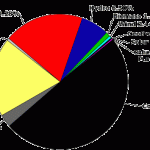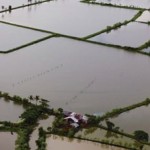 Stanford researchers have gotten a glimpse into an uncertain future where increasing levels of carbon dioxide in the Earth’s atmosphere will lead to higher levels in the ocean as well, leaving the water more acidic and altering underwater ecosystems.
Stanford researchers have gotten a glimpse into an uncertain future where increasing levels of carbon dioxide in the Earth’s atmosphere will lead to higher levels in the ocean as well, leaving the water more acidic and altering underwater ecosystems.
The glimpse comes from waters near Ischia, Italy, where unusual shallow-water volcanic vents in the floor of the Mediterranean Sea bubble carbon dioxide into the water, creating a local underwater neighborhood that may resemble the ocean of the future.
If the results are a prediction of the future, “you are left with a dramatically different ecosystem that is likely going to be less able to deal with stress and is going to have less biomass available to feed organisms higher up the food chain,” said Kristy Kroeker, a graduate student in biology at Stanford’s Hopkins Marine Station.
The special significance of this research site is that, unlike most hydrothermal vents, it spouts just carbon dioxide, without hot, sulfurous brews that are lethal to all but the most highly adapted extremophile organisms. The carbon dioxide comes out of the vents at the same temperature as the surrounding water. The carbon dioxide vents cause a local gradient in the seawater chemistry, with the greatest acidity closest to the vents. While the researchers found that various species reacted differently to the more acidified waters – some suffered, some prospered – their overall findings do not bode well for the biological community as a whole.
“The types of organisms that were winners in this acidified environment are functionally very different from those that were lost,” Kroeker said.
Kroeker is the lead author of a paper describing the research published recently in ‘Proceedings of the National Academy of Sciences’. Fiorenza Micheli, Professor of Biology at Hopkins Marine Station, is Kroeker’s thesis adviser and a co-author of the paper. Kroeker and her colleagues looked at invertebrate seafloor communities spread along a range of acidity, from the most acidic water right around the vents out to distances of 200 meters, where the acidity of the water was that of the ambient Mediterranean Sea.
The biggest losers were organisms with shells made of calcium carbonate, which dissolves in acidic water. Snails, clams, mussels and scallops were all absent from the extremely acidic zone. Small crabs, sea urchins, shrimps and species of worms that live in tubes of calcium carbonate attached to the rocks were also missing. Some of the worms were also absent from the intermediate zone, where the acidity was moderately greater than the ambient water.
“If you were to go snorkel along this gradient, you would see some variability within each zone, but the changes in the make-up of the ecological community are very clear when you move from one area to another,” Kroeker said. Moving into the most acidic zone, “The change is obvious within a single meter,” she said.
The winners tended to be very small-bodied organisms, in particular some shrimp-like crustaceans and small worms.
But ecology is not a zero-sum game, and in terms of the overall ecosystem, winners and losers don’t even out. Even with an increased abundance of the smaller organisms, the total biomass of the community is decreased because of the loss of the larger-bodied creatures, according to Kroeker. That could reduce the amount of food available for organisms higher in the food web. There is also less diversity in the biological community. The organisms that prospered tended to be generalists, while the number of specialist species dwindled in the extreme high acidity zone.
“It is a simplified community and you have fewer species, so each species plays a disproportionately more important role,” Kroeker said. “If something happens to one of those species, you are more likely to have larger effects in the ecosystem as a result, likely making it less stable.”
 An ecosystem may be able to withstand the loss of different species up to a point, but eventually, like a table that’s had too many of its legs knocked off, it will collapse.
An ecosystem may be able to withstand the loss of different species up to a point, but eventually, like a table that’s had too many of its legs knocked off, it will collapse.
The biggest drop in species diversity was observed in moving from the zone of intermediate acidity to the extremely acidic zone, suggesting that many species may be able to tolerate a modest increase in acidity before having to exit or expire.
Most computer models for the effects of global warming are designed to predict trends on a global scale and generally are based on conditions on the open ocean, which is an extremely stable environment showing little acidity (pH) variation on a daily cycle.
“The ocean as a whole might have one pH, but on the scale at which an organism experiences the acidification, things could look very, very different,” Kroeker said.
In areas where plant and animal life are abundant, pH would be influenced by algae absorbing carbon dioxide from the water during photosynthesis and animals releasing it during respiration, potentially making habitat-level acidity more variable. Areas of upwelling – where highly acidic water from the deep ocean is brought to the surface – can experience rapid changes in pH values. Along the coast of the western United States, for example, upwelling can cause the pH range over the course of a single day to fluctuate almost twice as much as the predicted increase in acidity for the ocean between now and 2100.
“Near-shore ecosystems that are affected by upwelling and by biological processes are quite likely to see acidification values that are more extreme than what we actually predict for the global oceans,” Kroeker said.
That could bode ill not just for the marine organisms living in near-shore waters, but also for the humans who have gotten used to feeding on that rich biota.
Funding for the research was provided by the National Science Foundation (NSF), the Stazione Zoologica Anton Dohrn, the Myers Oceanographic Trust and Stanford University.
Details of the Study:
Source: By Louis Bergeron, Stanford University.













